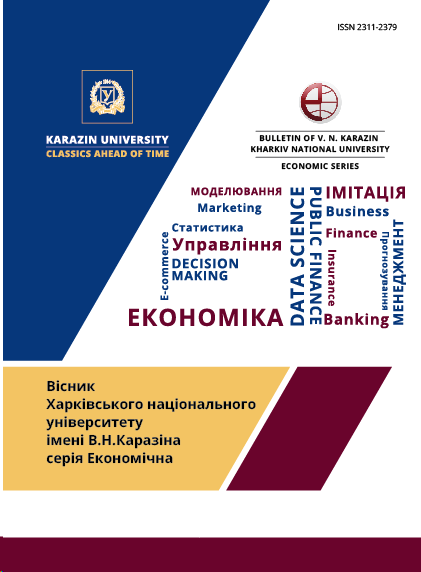Analyses of poverty indicators using PPI methodology
Abstract
Poverty is a negative socio-economical phenomenon which has a destructive influence on not only life quality for people who are caught in a poverty trap but for society in general. Poverty prevents society from realising its potential and leads to social development regression. The first of the sustainable development goals declared by the United Nations in 2025 as global goals of civilisation development until 2030, is to overcome poverty. The growth of poverty rates is observed for the first time in twenty years, and this requires studying the causes and developing policies to prevent this tendency. It is well-known poverty has various forms and national and cultural features, that should be taken into account when solving the poverty problem. One of the relevant tasks in studying this problem is the development of adequate methods of measuring poverty and determining the category of people who are considered poor This study aims to develop a clusterization model using the set of socio-economic indicators in order to identify the poor people cluster. The survey includes 8400 respondents from 7 European countries. Developing the model was carried out using machine learning methods in several steps: 1) data processing and statistical analyses; 2) selection of significant indicators by the classification model; 3) clustering by k-mean algorithm; 4) hierarchical clustering; 5) comparing outcomes of modeling and interpretation of results. The selection of indicators was carried out by classification methods using PPI methodology. Data processing and analyses were performed using Python. Using this approach we can split the population into groups with different living standards levels identifying the poor people group with a simple questionary considering national (local) features. This help to increase the effectiveness and timeliness of poor families’ support.
Downloads
References
United Nations. (2021). Poverty Eradication. Retrieved from https://www.un.org/development/desa/socialperspectiveondevelopment/issues/poverty-eradication.html.
Global MPI. (2023). 2023 global multidimensional poverty index. Annual report by the United Nations Development Program and Oxford Poverty and Human Development Initiative. Retrieved from https://hdr.undp.org/system/files/documents/hdp-document/2023mpireportenpdf.pdf
Vollmer, F., & Alkire, S. (2022). Consolidating and improving the assets indicator in the global Multidimensional Poverty Index. World Development, 158, 105997. doi: https://doi.org/10.1016/j.worlddev.2022.105997
Fried, A, Elmanharles, R.M. (Ed.). (1969). Booth's London. A Portrait of the Poor at the Turn of the Century, Drawn from His "Life and Labour of the People in London". Retrieved from https://www.routledge.com/Routledge-Revivals-Charles-Booths-London-1969-A-Portrait-of-the-Poor-at-the-Turn-of-the-Century-Drawn-from-His-Life-and-Labour-of-the-People-in-London/Fried-Elman/p/book/9781138283411
Hayek, F.A. (1994). The Road to Serfdom. London.
Polly, V. (2006). Poverty and Human Rights: Sen’s Contributions in Economics. Poverty and Human Rights: Sen's 'Capability Perspective. doi: https://doi.org/10.1093/acprof:oso/9780199273874.003.0004
Boianovsky, M. (2019). Divergence and convergence: Paul Samuelson on economic development. CHOPE Working Paper, No. 2019-07, Duke University, Center for the Historyof Political Economy (CHOPE), Durham, NC. Retrieved from https://www.econstor.eu/bitstream/10419/196164/1/1663561389.pdf
Strotmann, H., Volkert, J. (2018). Multidimensional Poverty Index and Happiness. J Happiness Stud, 19, 167-189. doi: https://doi.org/10.1007/s10902-016-9807-0
Ravallion, M. (2011). On multidimensional indices of poverty. J Econ Inequal, 9, 235-248. doi: https://doi.org/10.1007/s10888-011-9173-4
Sanchez, A., Sánchez, J.R., Barrera-Rojas, M.Á. (2020). The transformation of the concept of poverty: a challenge for the social sciences. Intersticios SocialesEl Colegio de Jaliscomarzo-agosto, 19, 39-65.
Banerjee, A., Duflo, E. (2018). The Economics of Poverty. How to free the world from poverty (trans. from English V. Plyskin). Kyiv: Nash format. (in Ukrainian)
Vikhrov, M. (2018). Arithmetic of poverty: how widespread is poverty in Ukraine, how does it threaten and are there any chances to overcome it? Ukr. Week, 9. P. 18-19. (in Ukrainian)
Husarevych, N., Serhiienko, O. and Shevchenko, J. (2020). Assessment of poverty in Ukraine and ways to overcome it. Investytsiyi: praktyka ta dosvid, 1, 86-91. doi: https://doi.org/10.32702/2306-6814.2020.1.86 (in Ukrainian)
Mishchuk, G.Yu., Yurchik, H.M. (2019). Social exclusion: problems of determining and assessing the scale in Ukraine. Demography and Soc. Economy, 1(35), 166-181. doi: https://doi.org/10.15407/dse2019.01.166 (in Ukrainian)
Poverty Probability Index. (2021). Getting Started with the PPI. Retrieved from https://www.povertyindex.org/get-started-ppi#Measure
Liberati, P., Resce, G., Tosi, F. (2022). The probability of multidimensional poverty: A new approach and an empirical application to EU-SILC data. Review of Income and Wealth, 69(3), 668-700. doi: https://doi.org/10.1111/roiw.12598
PPP Annual brochure. (2018). Fundamentals of Purchasing Power Parities. Retrieved from https://thedocs.worldbank.org/en/doc/332341517441011666-0050022018/original/PPPbrochure2017webformatrev.pdf
World Bank. (2023). New World Bank country classifications by income level. Retrieved from https://blogs.worldbank.org/opendata/new-world-bank-country-classifications-income-level-2022-2023
Oanda currency. (2021). Retrieved from https://www.oanda.com/currency-converter/en/?from=USD&to=PLN&amount=1
Lomazzi, V., Israel, S., Crespi, I. (2019). Gender Equality in Europe and the Effect of Work-Family Balance Policies on Gender-Role Attitudes. Soc. Sci, 8, 5. doi: https://doi.org/10.3390/socsci8010005
Halásková, R. (2019). Structural indicators for monitoring education and training systems in Europe. University of Ostrava. doi: https://doi.org/10.21125/iceri.2019.0684
Copyright (c) 2024 Merkulova T., Kosiashvili D.

This work is licensed under a Creative Commons Attribution 4.0 International License.

